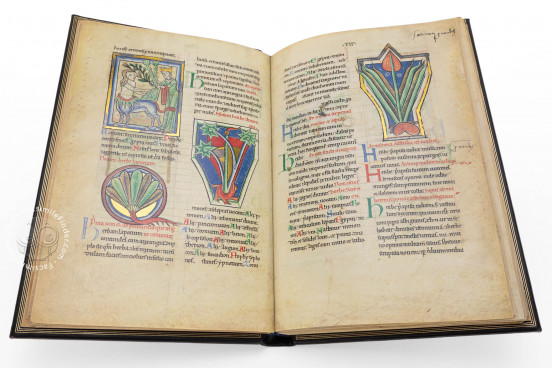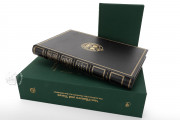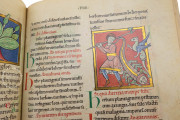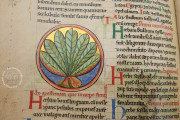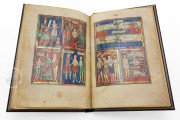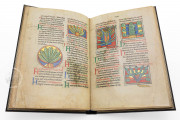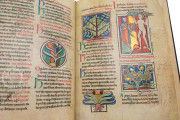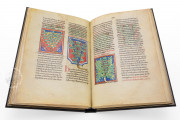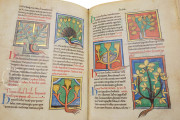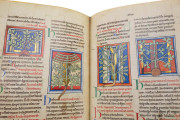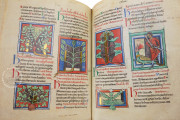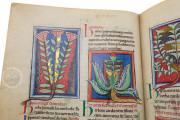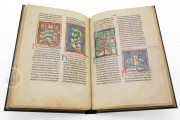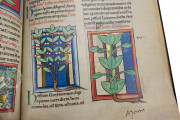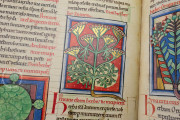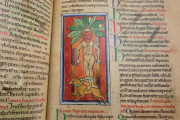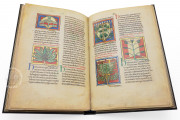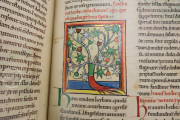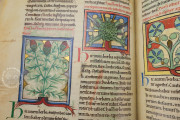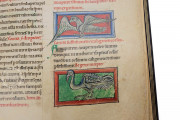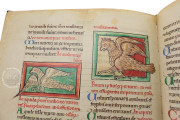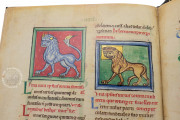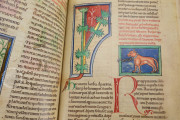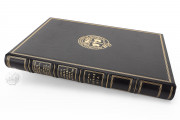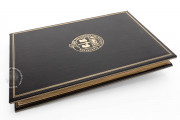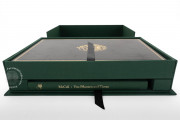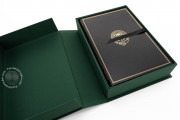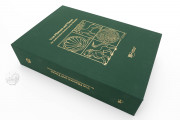The Medical and Herbal Miscellany is a collection of texts, most purporting to be of ancient Greek or Roman authority, that focus on the healing properties of plants and animal substances. Copied and illuminated in England or France, it dates from the 1190s. It is a handsome book, with framed miniatures that all feature some silver and/or gold. More than 200 column miniatures picture the sources for the medicines, and four larger miniatures show medical procedures.
The manuscript's longest texts are herbals—descriptions of plants and their medicinal properties—attributed to the second-century CE Platonic philosopher Apuleius and the first-century CE Greek physician Dioscorides Pedanius (fols. 12v-73r). These are joined by a text on remedies to be derived from animals by the fourth-century Roman physician Sextus Placitus (fols. 74r-93r).
Roots and All
The miscellany's miniatures of both plants and animals offer highly stylized renditions of their subjects, often against grounds divided into segments of bright color and precious metal. As aesthetically appealing as they are, they would have been of little use in helping the reader identify the species in nature. Nevertheless, the roots of almost all the plants are included, often extending in front of and beyond the miniatures' frames; this feature is entirely within the tradition of earlier herbals with naturalistic renderings of the plants.
Children, Swordsmen, and Centaurs
The belief that the urine of children could be useful for treating wrinkles or tempering a sword blade is illustrated by an image of a boy, naked and urinating into a bowl, and a girl, fully dressed (fol. 85v). Among the most charming of the miniatures in the herbal of Pseudo-Apuleius are those involving figures, which often take the shape of a man with a sword (fols. 12r, 14v, 24r, 38r, 43r) or a centaur (fols. 17v, 23r). For example, a man unsheathing his sword accompanied by his dog illustrates the efficacy of rue, a plant native to the Balkans, in treating rabies in dogs (fol. 38r).
Medical Practice Pictures
The manuscript concludes with a series of four miniatures—three full-page and one half-page—divided into two, three, or four scenes (fols. 91v-93r). They present a sequence beginning with a seated physician instructing an assistant and ending with an operation on the white of the eye. In between are images showing points on the body for the application of cautery—the drawing of excessive humors thought to cause illness—and operations, including one for hemorrhoids.
Neat Presentation
The text is written in two columns in the Transitional Script of the long twelfth century. Single-color initials of red, blue, and green open most paragraphs, and the headings are in red. Larger painted initials composed of vegetal motifs open three of the manuscript's texts (fols. 1v, 7v, and 8r).
Hans Sloane, Physician and Collector
Although there is no scholarly consensus concerning the manuscript's place of origin, it was in northeastern France by the fourteenth century when it was in the library of the Cistercian monastery of Notre-Dame at Ourscamp. The book may have been owned by the French bibliophile Paul Petau (1568-1614) before coming into the possession of the Irish physician and collector Hans Sloane (1660-1735). Sloane's manuscript collection was purchased from Sloane's executors for the British Museum library, founded in 1753. The manuscripts of the museum's library were transferred to the British Library in 1973.
We have 1 facsimile edition of the manuscript "Medical and Herbal Miscellany": Von Pflanzen und Tieren facsimile edition, published by Mueller & Schindler, 2023
Request Info / Price

